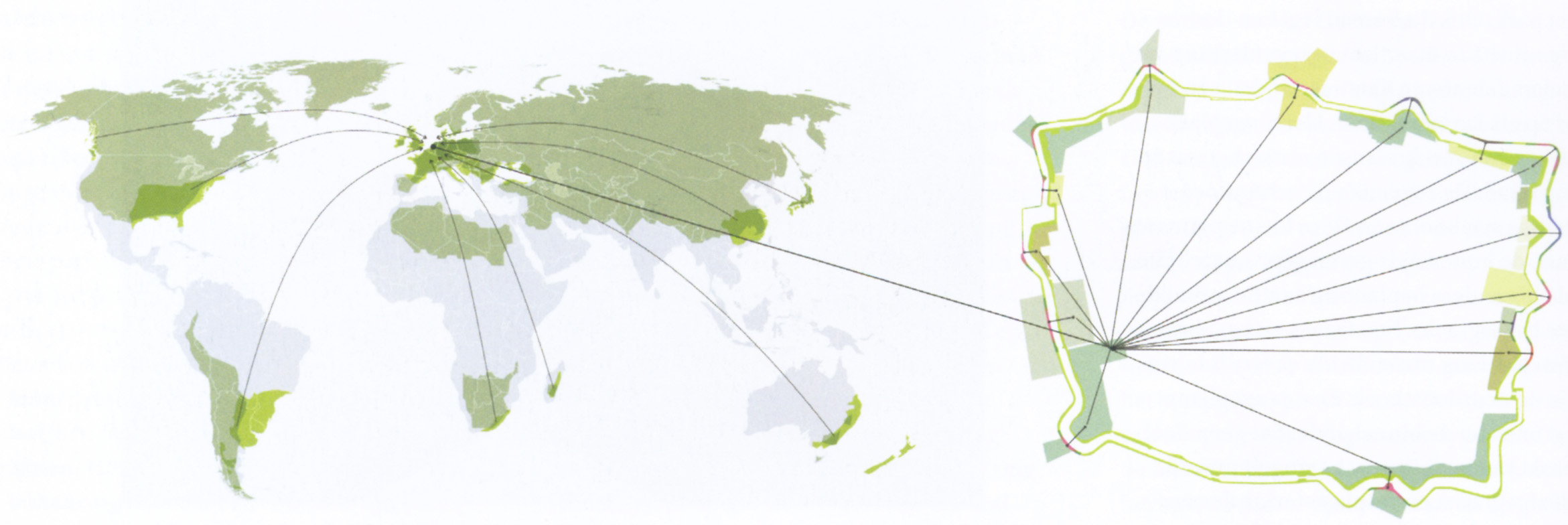
I wrote this essay for the book Lost Landscapes LOLA landscape architects brought out on winning the Rotterdam-Maaskant prize for Young Architects 2013. The philosophical and ethical dimensions of a radical planting concept such as LOLA proposed for the Singel Park in Leiden opens up the pandora’s box of confusion about what we think of as ‘nature’ and ‘natural’. Time for a reality check – or as Dirk Sijmons would say, “Welcome to the Anthropocene”.
RE-VISIONING NATURE
Against the rousing backdrop of its immense and diverse man-made landscapes, one would expect Dutch landscape architects to have developed a similar breadth of thinking on the concept of nature, their relationship to it, and the ways to elaborate on these ideas with design. More so given the rise of interest in nature internationally in recent decades, and the contribution by the Dutch with their own unique version of nature conservation: the design and construction of new natural areas. Moreover, the design of numerous parks, gardens and public open spaces here in the last few decades would be reasonably expected to have also provoked engagement with developing scientific, philosophical, aesthetic and ethical issues on nature. After a brief flurry of discussion during the launch of the ecological ‘mainframe’ for the Netherlands (EHS) in the 1990s however, things went quiet. Welcome news then, that a landscape design office such as Lola is engaging with nature on different levels in their work, such as in the Singel park competition in Leiden, won in 2011 together with Bureau Karst from Switzerland. A central idea in the scheme is a planting concept accentuating the diversity of green spaces around this six-kilometre long linear park. Under the theme ‘cosmopolitan nature’, their idea is to showcase plant communities from climatic zones similar to that of Leiden, from North and South America, South Africa, Madagascar, Australia, China and Japan. The idea however, was not greeted with the same enthusiasm as the rest of the scheme. Why use ‘alien’ species? Shouldn’t the design be using plants that were native to the area?
This response is grounded concepts such as biogeography, which divides plant species into specific plant districts around the world, determined by their abiotic, biotic and cultural conditions. Adepts of biogeography promote the use of plants from the geographic regions in which the project is located, a movement that has increasingly influenced garden and landscape design in the last hundred years. Lola’s scheme challenges the principles of biogeography initially for aesthetic reasons, but also questions fundamental concepts in biogeography. To begin with, how does one decide what is a ‘native’ and what is an ‘alien’ species? From the perspective of evolutionary biology the concept of native and alien is certainly fluid. Plants and plant communities are anything but static, developing and adapting to different circumstances over millennia. Native or alien thus depends on when one looks at the deep-time clock. Moreover, native and alien is also a question of cultural history, particularly in the Netherlands. Many of the plants we now consider native, migrated here in the holds of cargo ships or war fleets or were introduced by new cultures, first from Europe, later elsewhere. Dutch nature has been termed a ‘mosaic of memories’ by the biologist Piet Schroevers, a curious inter-relationship between shifts in biodiversity and periods of discovery, trade and contact between the Netherlands and the rest of the world.[i]
Lola’s planting concept is a very literal demonstration of this mosaic, but also has an important ethical component to it. If part of the reasoning for planting is that we are respecting an organism’s intrinsic value, on what basis do we decide that plants only ‘belong’ in one particular district and not in another, and thus which organism has more value than the other? And if we were to apply the same rules to humans, wouldn’t we certainly be infringing on fundamental human rights? Suddenly a scientific concept starts to display dubious political undertones; Jewish people were prohibited from gardening with native plants in Nazi Germany, a doctrine linked to the concept of biogeography. Lola’s scheme also exposes broader problems in mainstream ecological theory and biodiversity thinking in relation to the nature/culture duality and our cultural and urban landscapes. The correlation between biodiversity loss and environmental quality and urbanization for instance, is highly dependent on geographical and political contexts; while population growth and urbanization in third world countries is certainly detrimental to biodiversity, in many first world countries the opposite is true: biodiversity in many European cities now exceeds that of most non-urban territories in mainland Europe.[ii] Urban biodiversity stems in a large part from hybrid forms of nature in urban environments – ‘cosmopolitan’ nature.
More fundamentally, by taking on mainstream ecosystem principles we choose to narrow our focus to the understanding and mitigation of urbanizing societies’ effect on ecosystems, thereby perpetuating a fundamental distinction between man and nature in our approach. Without discounting that there are obvious problems resulting from the sprawl of urban areas and growth of urban populations, the continued distinction between man and nature is increasingly problematic. We are now seeing that the divide between man and nature is eroding and that hybrids are appearing (for example, the question whether climate is a natural system or a co-production of human and natural influences) and that inter-dependencies are being rediscovered, making way for a new consensus: that society and nature may still be distinguished from each other but not separated. Indeed, the illusion of separation is perhaps in itself the causes of many pressing global problems.[iii]
[i] Schroevers, P. 1998, Oorden van Onthouding, Rotterdam, NAI press.
[ii] Gilbert, O. L. 2005, Urban ecology: Progress and problems. Journal of Practical Ecology and Conservation Special Series, 4, 5–9.
[iii] Sijmons, D. 2013, Waking up in the Anthropocene. March 2013. From: http://iabr.nl/en/curator/. [13 September 2013].